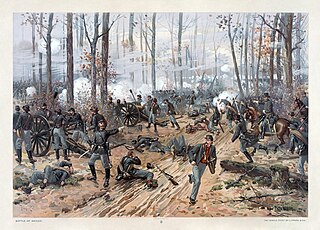
Back معركة شيلوه Arabic Batalla de Shiloh Catalan Slaget ved Shiloh Danish Schlacht von Shiloh German Batalo de Shiloh Esperanto Batalla de Shiloh Spanish Shilohko gudua Basque نبرد شایلو Persian Shilohin taistelu Finnish Bataille de Shiloh French
| Battle of Shiloh (Battle of Pittsburg Landing) | |||||||
|---|---|---|---|---|---|---|---|
| Part of the Western Theater of the American Civil War | |||||||
 The Battle of Shiloh by Thulstrup | |||||||
| |||||||
| Belligerents | |||||||
|
|
| ||||||
| Commanders and leaders | |||||||
| Units involved | |||||||
| Army of Mississippi | |||||||
| Strength | |||||||
66,812
| 44,699 | ||||||
| Casualties and losses | |||||||
13,047
|
10,699
| ||||||
Location within the state of Tennessee | |||||||
The Battle of Shiloh, also known as the Battle of Pittsburg Landing, was a major battle in the American Civil War fought on April 6–7, 1862. The fighting took place in southwestern Tennessee, which was part of the war's Western Theater. The battlefield is located between a small, undistinguished church named Shiloh and Pittsburg Landing on the Tennessee River. Two Union armies combined to defeat the Confederate Army of Mississippi. Major General Ulysses S. Grant was the Union commander, while General Albert Sidney Johnston was the Confederate commander until his battlefield death, when he was replaced by his second-in-command, General P. G. T. Beauregard.
The Confederate army hoped to defeat Grant's Army of the Tennessee before it could be reinforced and resupplied. Although it made considerable gains with a surprise attack on the first day of the battle, Johnston was mortally wounded and Grant's army was not eliminated. Overnight, Grant's Army of the Tennessee was reinforced by one of its divisions stationed farther north, and was also joined by portions of the Army of the Ohio, under the command of Major General Don Carlos Buell. The Union forces conducted an unexpected counterattack in the morning, which reversed the Confederate gains of the previous day. The exhausted Confederate army withdrew further south, and a modest Union pursuit started and ended on the next day.
Though victorious, the Union army had more casualties than the Confederates. After the surprise and lengthy Union casualty list became known, Grant was heavily criticized; in fact, decisions made by both the Federal and Confederate high command were afterward questioned by individuals on and off the battlefield. The battle was the costliest engagement of the Civil War up to that point, and its nearly 24,000 casualties made it one of the bloodiest battles of the entire war.

